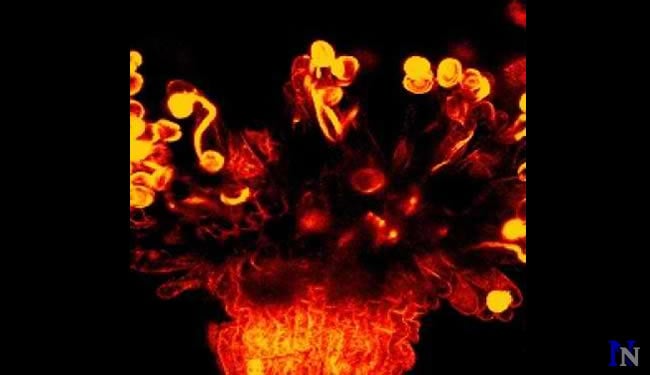Research using tobacco plants and Arabidopsis Thaliana weeds has answered long standing mysteries about sexual reproduction in plants. The research also shows that some cellular communication mechanisms used in animal nervous systems are also used by plants.
For over 20 years scientists have tried to describe the molecular nature of calcium channels in the outer membrane of plant cells. Other questions remained regarding the roles of glutamate receptor-like channel (GLRs) genes and D-serine in pollen grains. Genetic, pharmacological and electrophysiological techniques have finally lead to answers.
By impairing glutamate receptor-like channels in male organs, researchers showed that organs became partially sterile, leading to lower seed production and abnormal pollen tubes.
D-serine was found to activate the GLRs at the tip of pollen tubes which allowed calcium ion influx to the tubes. The researchers then showed that female sexual organs produced D-serine. Female sexual organs missing D-serine lead to deformed pollen tubes. These findings suggest that D-serine from female sexual organs helps guide pollen tubes to their final target during sexual reproduction.
These cell-cell communication mechanisms are very similar to those seen in animal nervous systems. D-serine and glutamate receptors both play large roles in learning and memory in animal central nervous systems. The release reports that researcher José Feijó says the ” findings, implicating analogous genes in growth processes in both plants and animals, underscores how evolution re-uses successful mechanisms, over and over again.”
Research such as this could lead to new models for studying human genes involved in neurodegenerative diseases such as multiple sclerosis, Alzheimer’s disease, Huntington’s disease and others.
Further explanations and details about these new findings are provided in the press release below.
Sexual plant reproduction: Male and female talk in the same way as do cells in your brain
A team of researchers at the Instituto Gulbenkian de Ciência (IGC), Portugal, discovered that pollen, the organ that contains the plant male gametes, communicate with the pistil, their female counterpart, using a mechanism commonly observed in the nervous system of animals. This study not only reveals a new mechanism which underlies reproduction in plants, but also opens an exciting new avenue in the study of how cell-cell communication is conserved between animals and plants. The research is to be published this week in Science Express of the journal Science, published by the AAAS, the science society, and the world’s largest general scientific organization.
For many years biologist have observed regular oscillations in several parameters that control growth of pollen tubes, such as pH (concentration of proton ions) and calcium ions, but the actual molecular channels that control these oscillations and their physiological output have remained elusive. Led by José Feijó, group leader at the IGC and Professor at Lisbon University, this international team have now discovered that the oscillations of calcium ions in the growing pollen tubes of tobacco and the weed Arabidopsis are facilitated by channels called Glutamate receptors-like (GLRs), and that these channels are opened by, amongst other components, a rare aminoacid, D-serine (D-Ser). Both D-Ser and GLRs are key molecular players in cell-cell communication in the animal central nervous systems, at various levels: they play a central role in memory and learning processes in the brain, and have been implicated in a wide range of neurodegenerative diseases such as multiple sclerosis, Alzheimer, Huntington’s disease and others. And now, surprisingly, they also have a role in reproduction of plants.
Working in the IGC laboratories, the team used an extensive combination of genetic, pharmacologic and electrophysiological techniques to reveal the role of glutamate receptor-like (GLRs) genes and D-serine in pollen grains, and their physiological impact on plant reproduction. In proving that GLRs are calcium channels, the team also solved two long-standing riddles in plant biology: the molecular nature of calcium channels in the outer membrane of plant cells, a central question in plant physiology elusive for more than 20 years, and what are the functions of GLRs genes in plants, a fact that has puzzled biologists ever since the first genome of the model plant Arabidopsis was sequenced.
Plant reproduction is a complex and highly coordinated process. Pollen grains, which contain the plants’ male gametes (sperm cells), are carried from the male organ of the flower (the stamen) to the female organ (the pistil). Here the pollen germinates and grows a pollen tube, which extends and is guided to the ovary, where it releases the sperm. The sperm fuse with the egg cells, giving rise to an embryo, part of the seed.
In this study, the researchers showed that impairing the GLR functions in male gametes leads to partial male sterility: fewer seeds are produced by the plant, and the pollen tubes are abnormal. Furthermore, D-serine activates the GLRs on the tips of pollen tubes, allowing calcium ions to flow into the tube. They took their research a step further demonstrating that D-serine is indeed produced in the female sexual organs, and that absence of D-serine in these organs also leads to deformed pollen tubes. Together, these findings strongly suggest that D-serine, produced in the female sexual organs may have a role in guiding pollen tubes to their final target.
José Feijó says “Pollen tubes are a model system for cellular tip-growth, a process common to fission yeast, filamentous fungi, the root hairs of plants and nerve cells. Our findings, implicating analogous genes in growth processes in both plants and animals, underscores how evolution re-uses successful mechanisms, over and over again. We feel that our research, performed in Arabidopsis and tobacco, now opens doors for the study of conserved cell-cell communication processes, across plant and animals species”.
Notes about this research
Contact: Silvia Castro – Instituto Gulbenkian de Ciencia
Source: IGC press release
Image Source: Image adapted from press release image by Jose Feijo / Instituto Gulbenkian de Ciencia.









